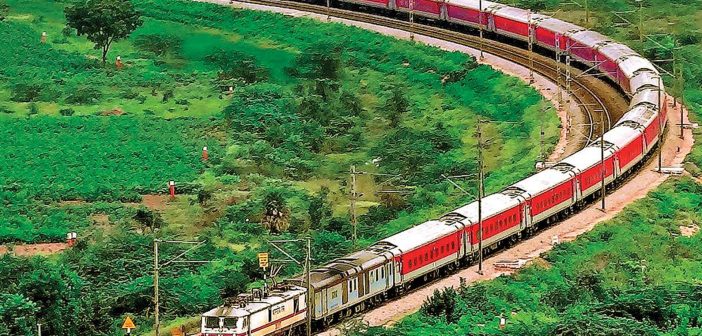Indian Railways, the lifeblood of India’s transportation network, has demonstrated a remarkable resurgence in passenger and freight traffic during the financial year 2023-24 (FY23-24). This report delves into the details of this growth, analyzing the increase in passenger and freight volumes, exploring the contributing factors, and examining the implications for the future of Indian Railways.
Surge in Passenger Traffic
Passenger ridership on Indian Railways witnessed a significant uptick in FY23-24, surpassing pre-pandemic levels. Reports from The Economic Times indicate a total of 648 crore passengers having travelled during this period, a noteworthy increase of 52 crore compared to FY22-23 [1]. This translates to a growth rate of over 8.8%, signifying a robust recovery from the pandemic-induced slump in passenger travel.
Reasons for Passenger Growth
Several factors have contributed to the rise in passenger traffic. Firstly, the easing of pandemic restrictions and increased public confidence in travel have played a major role. Additionally, initiatives by Indian Railways to enhance passenger experience, such as the introduction of modern coaches like the Tejas Express and Vande Bharat trains, and improved catering services through partnerships with IRCTC, have likely attracted more travellers [2]. The expansion of regional connectivity through new train routes, for example, the introduction of the Ramayana and Kashi Yatra trains, and increased frequency on existing routes has also made rail travel a more accessible and attractive option for many.
Freight Traffic on the Rise
Indian Railways has also displayed positive growth in freight movement during FY23-24. While official figures for the entire financial year are yet to be released, data available up to November 2023 suggests a promising trend. According to a Press Release by the Press Information Bureau, Indian Railways achieved a cumulative freight loading of 1015.67 million tonnes (MT) from April to November 2023, surpassing the 978.72 MT achieved during the same period in the previous year [3]. This represents an increase of approximately 36.945 MT, translating to a growth rate of nearly 3.8%.
Drivers of Freight Growth
The rise in freight traffic can be attributed to several factors. The ongoing economic revival in India has stimulated demand for transportation of goods across the country. Additionally, Indian Railways’ focus on key sectors like coal and iron ore transportation, registering an 8% and 13% increase respectively as reported by Business Standard, has yielded positive results [4]. Improved operational efficiency through initiatives like faster track doubling and electrification projects, and a renewed focus on attracting new customers through competitive rates and streamlined logistics solutions may have also contributed to the growth.
Challenges and Opportunities
Despite the positive trends, Indian Railways faces challenges in sustaining this growth momentum. Upgrading aging infrastructure, including a focus on improving station facilities and amenities for passengers, remains a priority. Streamlining operations for faster turnaround times, particularly for freight trains, and enhancing customer service through digitalization and improved grievance redressal mechanisms are other areas for continued focus.
Nevertheless, with continued government investment through initiatives like the Dedicated Freight Corridor (DFC) project, strategic planning that leverages technology for route optimization and predictive maintenance, and a commitment to innovation in areas like hydrogen-powered trains, Indian Railways is well-positioned to capitalize on the expanding freight market and solidify its position as the nation’s preferred mode of mass transportation.
Impact on Related Sectors
The growth of Indian Railways has a significant impact on related sectors. Increased passenger traffic translates to a boost in tourism, particularly for destinations well-connected by rail. The efficiency and affordability of rail freight transportation benefit various industries like manufacturing and agriculture by facilitating the movement of raw materials and finished goods across the country. Additionally, the logistics sector thrives on the reliable and extensive network of Indian Railways, creating job opportunities and streamlining supply chains.
Comparison with Other Modes of Transportation
While Indian Railways enjoys a dominant position in passenger and freight transportation in India, it faces competition from other modes. Road transport offers door-to-door convenience and flexibility, particularly for shorter distances. However, rising fuel costs and congestion on major highways make rail travel a more economical and time-efficient option for long journeys. Air travel remains a preferred choice for faster long-distance commutes, but its higher cost limits its accessibility for a large segment of the population.
Future Vision and Sustainability
The future vision for Indian Railways is one of continued growth, modernization, and sustainability. The government’s ambitious plans for high-speed rail corridors and further electrification of tracks aim to provide faster and more efficient travel experiences. Technological advancements in areas like automation and artificial intelligence can further improve operational efficiency and safety. Additionally, a focus on renewable energy sources like solar power for
station operations and biofuels for locomotives will contribute to a more sustainable future for Indian Railways. This aligns with India’s national sustainability goals and will help reduce the carbon footprint of the transportation sector.
Conclusion
FY23-24 has been a year of significant progress for Indian Railways. The growth in both passenger and freight traffic underscores the critical role railways play in India’s economic and social development. By addressing existing challenges, embracing innovation, and capitalizing on new opportunities, Indian Railways can ensure its continued success as a vital pillar of the nation’s infrastructure network. As India strives towards a more sustainable future, Indian Railways has the potential to become a model for clean and efficient mass transportation, connecting people, businesses, and regions across the country.





